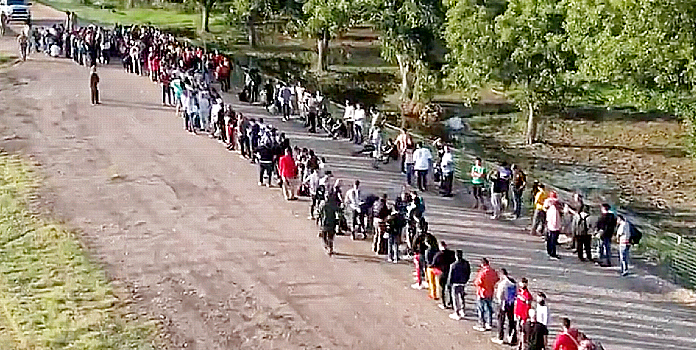(José Niño, Headline USA) With the border under control, the question remains: Should America open its doors to more legal immigrants for economic reasons?
According to Customs and Border protection data, February 2025 saw only 8,347 illegal alien border crossings along the southwest border, representing a 71% decrease from January 2025 (29,101) and a 94% decrease from February 2024 (140,641).
March 2025 recorded 7,181 apprehensions, an additional 14% decrease from February and a 95% decrease from March 2024 (137,473).
In March 2025, CBP reported “the lowest southwest border crossings in history,” with U.S. Border Patrol averaging approximately 264 apprehensions per day nationwide.
This low number of border crossings has prompted The Wall Street Journal to suggest that Donald Trump should now welcome more economic migrants through legal channels. The WSJ’s editorial board, which supports increasing immigration, posed the political questioned: “The question is whether Mr. Trump can use the political capital from his border victory to achieve a more lasting immigration success.”
According to the WSJ’s editors, Trump’s “opportunity” for “immigration success” should “include more pathways for legal immigration to address the labor needs of a growing economy.”
Half of small businesses claim one of their largest problems is finding workers. The editors pose the question: “If Mr. Trump wants more fruits and vegetables grown at home, who’s going to pick them?” They also ask, “If Mr. Trump wants Silicon Valley to win the AI race, why are H-1B skilled visas capped at a low number and handed out by lottery?”
The WSJ’s argument for increasing legal immigration comes at a time when the consensus on the support for mass migration is breaking down. For example, Vice President JD Vance likened the allure of cheap labor as “a drug that too many American firms got addicted to … [and] cheap labor is a problem precisely because it’s been bad for innovation.” He continued, “Real innovation makes us more productive, but it also, I think, dignifies our workers. It boosts our standard of living. It strengthens our workforce and the relative value of its labor.”
.@VP Vance on AI: "Real innovation makes us more productive, but it also dignifies our workers… As Americans, all of us should be particularly proud of our extraordinary heritage. It is American heritage of inventing things." pic.twitter.com/2EwtKJsSCg
— Rapid Response 47 (@RapidResponse47) March 18, 2025
Harvard economist George Borjas has produced influential work suggesting that immigration places significant downward pressure on wages. His research indicates a wage elasticity of immigration between -0.3 and -0.4. In other words, if immigration increases by 10%, wages fall by 3-4% for workers with similar characteristics.
Applying this approach to data from the timeframe of 1980 to 2000, Borjas found that immigrants reduced the average wage of native workers with similar education and work experience by 3-4%, with effects reaching 9% for the least skilled workers.
Borjas’ long work questioning immigration has shaped populist critiques of the purported benefits of mass migration, which has been a bipartisan policy prescription since the 1960s.
Whether Trump’s immigration policies will pave the way for a new era of legal immigration remains to be seen, but the stakes for American workers and businesses are higher than ever.
José Niño is the deputy editor of Headline USA. Follow him at x.com/JoseAlNino

